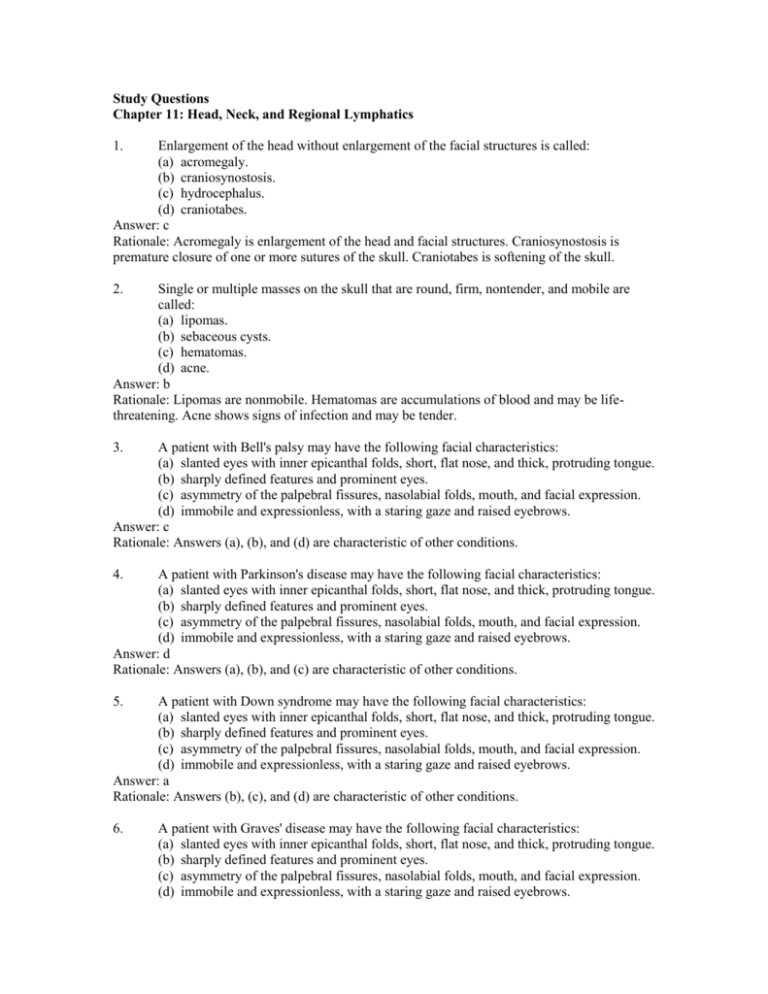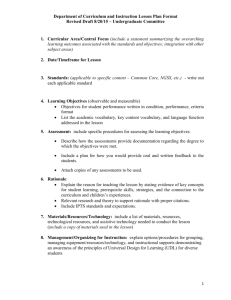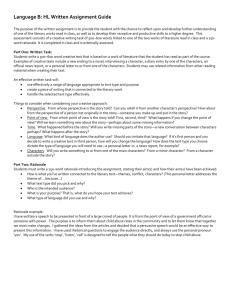
Study Questions
Chapter 11: Head, Neck, and Regional Lymphatics
1.
Enlargement of the head without enlargement of the facial structures is called:
(a) acromegaly.
(b) craniosynostosis.
(c) hydrocephalus.
(d) craniotabes.
Answer: c
Rationale: Acromegaly is enlargement of the head and facial structures. Craniosynostosis is
premature closure of one or more sutures of the skull. Craniotabes is softening of the skull.
2.
Single or multiple masses on the skull that are round, firm, nontender, and mobile are
called:
(a) lipomas.
(b) sebaceous cysts.
(c) hematomas.
(d) acne.
Answer: b
Rationale: Lipomas are nonmobile. Hematomas are accumulations of blood and may be lifethreatening. Acne shows signs of infection and may be tender.
3.
A patient with Bell's palsy may have the following facial characteristics:
(a) slanted eyes with inner epicanthal folds, short, flat nose, and thick, protruding tongue.
(b) sharply defined features and prominent eyes.
(c) asymmetry of the palpebral fissures, nasolabial folds, mouth, and facial expression.
(d) immobile and expressionless, with a staring gaze and raised eyebrows.
Answer: c
Rationale: Answers (a), (b), and (d) are characteristic of other conditions.
4.
A patient with Parkinson's disease may have the following facial characteristics:
(a) slanted eyes with inner epicanthal folds, short, flat nose, and thick, protruding tongue.
(b) sharply defined features and prominent eyes.
(c) asymmetry of the palpebral fissures, nasolabial folds, mouth, and facial expression.
(d) immobile and expressionless, with a staring gaze and raised eyebrows.
Answer: d
Rationale: Answers (a), (b), and (c) are characteristic of other conditions.
5.
A patient with Down syndrome may have the following facial characteristics:
(a) slanted eyes with inner epicanthal folds, short, flat nose, and thick, protruding tongue.
(b) sharply defined features and prominent eyes.
(c) asymmetry of the palpebral fissures, nasolabial folds, mouth, and facial expression.
(d) immobile and expressionless, with a staring gaze and raised eyebrows.
Answer: a
Rationale: Answers (b), (c), and (d) are characteristic of other conditions.
6.
A patient with Graves' disease may have the following facial characteristics:
(a) slanted eyes with inner epicanthal folds, short, flat nose, and thick, protruding tongue.
(b) sharply defined features and prominent eyes.
(c) asymmetry of the palpebral fissures, nasolabial folds, mouth, and facial expression.
(d) immobile and expressionless, with a staring gaze and raised eyebrows.
Answer: b
Rationale: Answers (a), (c), and (d) are characteristic of other conditions.
7.
Torticollis is a condition that causes:
(a) pain with flexion or rotation of the head.
(b) a clicking or snapping sound when the mouth is opened.
(c) lateral deviation of the patient's neck.
(d) a mass palpated in the musculature of the neck.
Answer: c
Rationale: Torticollis is abnormal contractions of the sternocleidomastoid and possibly the
trapezius and scalene muscles. Answers (a), (b), and (d) are characteristic of other conditions.
8.
The Adam's apple is the common term for the:
(a) parathyroid gland.
(b) thyroid cartilage.
(c) hyoid bone.
(d) larynx.
Answer: b
Rationale: Answers (a), (c), and (d) refer to other, nearby structures.
9.
Which of the following would lead you to suspect cancer in a patient with a mass in the
thyroid gland (choose two)?
(a) diet high in iodine
(b) male gender
(c) history of head or neck radiation, especially in childhood
(d) a solitary nodule in the thyroid tissue
Answer: c, d
Rationale: A solitary nodule is suggestive of carcinoma in thyroid tissue. Risk factors for thyroid
cancer include a history of head or neck radiation, a diet low in iodine, and being female.
10.
Which lymph nodes are sometimes enlarged in patients with ear infections?
(a) postauricular
(b) occipital
(c) tonsillar
(d) submental
Answer: a
Rationale: Lymph nodes tend to enlarge in the area near an infection or when draining an area
with pathology.
11.
An enlargement of Virchow's node, which is found in the following group of lymph
nodes, suggests a possible malignancy in the abdominal or thoracic regions:
(a) anterior cervical chain
(b) posterior cervical chain
(c) supraclavicular area
(d) tonsillar area
Answer: c
Rationale: Lymph nodes tend to enlarge in the area near an infection or when draining an area
with pathology.
Copyright © 2006 Thomson Delmar Learning. All rights reserved.






